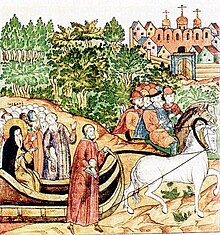Stephen of Perm
| Stephen of Perm | |
|---|---|

Saint Stephen on his way to Moscow
|
|
| "The Enlightener of Perm" Bishop of Perm |
|
| Born | 1340 Veliky Ustyug, Russia |
| Died | 1396 Moscow, Russia |
| Venerated in |
Roman Catholic Church Eastern Orthodox Church |
| Feast | April 26 |
Stephen of Perm (Russian : Стефан Пермский, also spelled "Stephan", Komi: Перымса Стефан; 1340–1396) was a fourteenth-century painter and missionary credited with the conversion of the Komi to Christianity and the establishment of the Bishopric of Perm'. Stephen also created the Old Permic script, which makes him the founding-father of Permian written tradition. "The Enlightener of Perm" or the "Apostle of the Permians", as he is sometimes called, is commemorated by the Catholic and Orthodox Churches on April 26.
Stephen was probably from the town of Ustiug. According to a church tradition, his mother was a Komi woman. Stephen took his monastic vows in Rostov, where he learned Greek and learned his trade as a copyist. In 1376, he voyaged to lands along the Vychegda and Vym rivers, and it was then that he engaged in the conversion of the Zyriane (Komi peoples). Rather than imposing the Latin or Church Slavonic on the indigenous pagan populace, as all the contemporary missionaries did, Stephen learnt their language and traditions and worked out a distinct writing system for their use, creating the second oldest writing system for an Uralic language. Although his destruction of pagan idols (e.g., holy birches) earned him the wrath of some Permians, Pimen, the Metropolitan of All Rus', created him as the first bishop of Perm'.
The effect of the new bishopric and the conversion of the Vychegda Perm threatened the control that Novgorod had been enjoying over the region's tribute. In 1385, the Archbishop of Novgorod Aleksei (r. 1359-1388) sent a Novgorodian army to oust the new establishment, but the new bishopric, with the help of the city of Ustiug, was able to defeat it. In 1386, Stephan visited Novgorod, and the city and its archbishop formally acknowledged the new situation. Subsequently, the region's tribute became the luxury of Moscow. These events had immense repercussions for the future of northern Russia, and formed but one part of a larger trend which saw more and more of the Finnic North and its precious pelts passing from the control of Novgorod to Moscow.
...
Wikipedia
